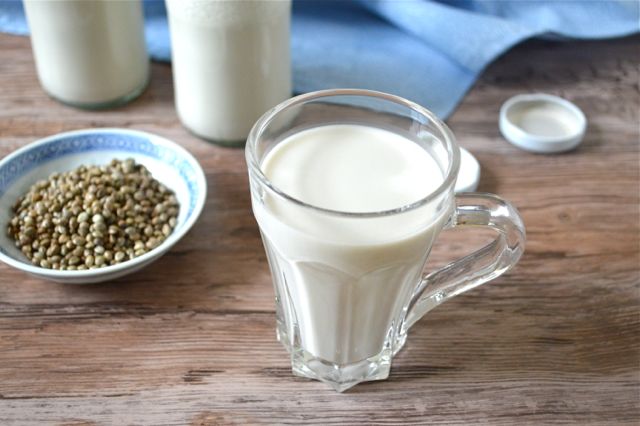Milk is the most nutritive, naturally occurring liquid food in the world. As an agricultural product, milk, also called dairy milk, is extracted from farm animals during or soon after pregnancy. India is the world’s largest producer of milk,and is the leading exporter of skimmed milk powder. humans consume milk beyond infancy, using the milk of other mammals (especially cattle, goats and sheep) as a food product. Around 85% of all milk worldwide was produced from cows. However we also gets milk from other animals like Buffalo, Goat, Sheeps, camel etc.
Milk is processed into a variety of products such as cream, butter, yogurt, kefir, ice cream, and cheese. Modern industrial processes use milk to produce casein, whey protein, lactose, condensed milk, powdered milk, and many other food-additives and industrial products.
Composition of cow Milk-
Whole cow’s milk is composed of about approx. 88% water, 3-4% proteins made up mostly of whey and casein, 5% sugar in the form of lactose, and 3-6% fat.
It is the near-perfect single food containing protein, carbohydrate, fat, minerals and vitamins. However, it is lacking in iron, vitamin C and D. It is one of the most complete foods, because it contains the nutrients required for growth and development. However, the milk composition cannot remain same all the time and will vary slightly, depending upon the cow species, age, animal food, lactation period etc. Animals who feed on grass pastures produce a high yield of milk, richer in Vitamin A.
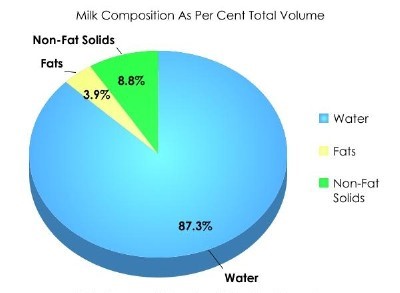
Nutritional value of Milk-
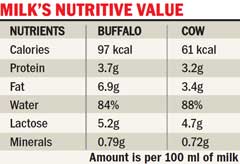
Milk Protein:-
Protein:- Milk contains approx. 3-4 % of protein of its total weight. Milk proteins contain all 9 essential amino acids required by humans. Proteins in milk can be divided into two groups based on their solubility in water. Insoluble milk proteins are called casein, whereas soluble proteins are known as whey proteins. Both of these groups of milk proteins are considered to be of excellent quality, with a high proportion of essential amino acids and good digestibility.
Casein(Insoluble milk protein)- Casein forms the majority — or 80% — of proteins in milk. One important property of casein is its ability to increase the absorption of minerals, such as calcium and phosphorus.
Whey protein (Soluble milk protein)- Whey protein is another family of proteins, accounting for 20% of the protein content in milk. Whey proteins have been associated with many beneficial health effects, such as decreased blood pressure and improved mood during periods of stress. Whey protein is excellent for growing and maintaining muscles.
Milk fat
Whole milk straight from the cow is around 4-6% fat. The fat constituent of milk is present in the form of cream. It is dispersed as fine globules. When heated, it rises to the surface, where it forms a layer. It contains fat-soluble vitamin A and D.
Whole milk is very high in saturated fats, which make up about 70% of its fatty acid content. Polyunsaturated fats are present in minimal amounts, making up around 2.3% of the total fat content. Monounsaturated fats make up the rest — about 28% of the total fat content.
- Carbohydrates in Milk:-
Carbohydrates in milk are mainly in the form of the simple sugar lactose, which makes up around 5% of milk. In your digestive system, lactose breaks down into glucose and galactose. Lactose also tends to crystallize in milk powder during storage and results in lump formation and caking. It isn’t water soluble and is responsible for the sandy or gritty texture in condensed milk and ice-cream. In the souring of milk, lactic acid bacteria converts lactose into lactic acid, giving sour milk its characteristic. flavour. Lactose are absorbed into your bloodstream, at which point your liver converts galactose into glucose.
Milk contains all the vitamins and minerals necessary to sustain growth and development. It also provides almost every single nutrient needed by humans — making it one of the most nutritious foods available. Milk is rich in calcium, phosphorus, sodium, potassium and all the vitamins known to be essential for human nutrition are present in milk. Milk is rich in Vitamin A, D, E and K.
Processing of Milk: –
All milk sold for human consumption is processed in some way. This is done to increase the safety and shelf life of milk products. There are many way to process the milk to enhance the shelf life of the milk products.
- Collection, Filtration & Chilling of Milk:-Milk is obtained from the cow (or goat, sheep, or water buffalo) under sanitary conditions and cooled to 45°F (7°C) within 2 hours of milking. Milk at the plant is stored at less than 45°F (7°C) and is usually processed within 24 hours, but can held for up to 72 hours (3 days) before processing. Longer holding time allows for growth of spoilage organisms that grow at refrigerator temperatures, called psychrotrophs. Almost all of the milk in the processing plant is pasteurized, with the exception of some raw milk cheese production and some states that allow the sale of raw milk. The conditions of the heat treatment used for pasteurization depends on the final product – lower temperatures are used for refrigerated products and higher heat treatments are used for products stored at room temperature.
- Pasteurization of Milk: –
Pasteurisation was invented by a French Scientist called Louis Pasteur during the nineteenth century.
Pasteurization is the process of heating milk up and then quickly cooling it down to eliminate certain bacteria. For effective pasteurization, milk can be heated up to 145 degrees Fahrenheit ( 62.8 degree C) for 30 minutes. But this method isn’t very common. More common is heating milk up to at least 161.6 degrees Fahrenheit for 15 seconds, which is known as High-temperature Short-Time (HTST) pasteurization, or flash pasteurization. This method will keep milk fresh for two to three weeks.
then there’s Ultra-Heat Treatment (UHT), whereby milk is heated to 280 degrees Fahrenheit for a minimum of two seconds. This processing results in a shelf life that can extend up to nine months.
Milk treated with pasteurization or HTST is labeled as “pasteurized,” while milk treated with UHT is labeled as “ultra-pasteurized.”
Pasteurization Time & Temperature chart for Milk
| Type or Method | Typical Product | Temperature | Pasteurization Holding Time |
| Normal Pasteurization | Milk | 145°F (62.8°C) | 30 min |
| High temperature short time (HTST) pasteurization | Milk | 161°F (71.7°C) | 15 sec |
| Continuous, higher heat shorter time (HHST) | Milk | 191°F (88.3°C) | 1 sec |
| Ultra-pasteurization | Milk and cream | 280°F (137.8°C) | 2 sec |
| Ultra-high temperature Pasteurization (UHT) | Milk | 275-302°F (135-150°C) | 4-15 sec |
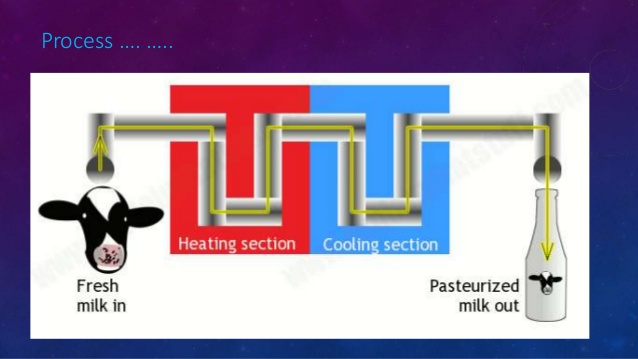
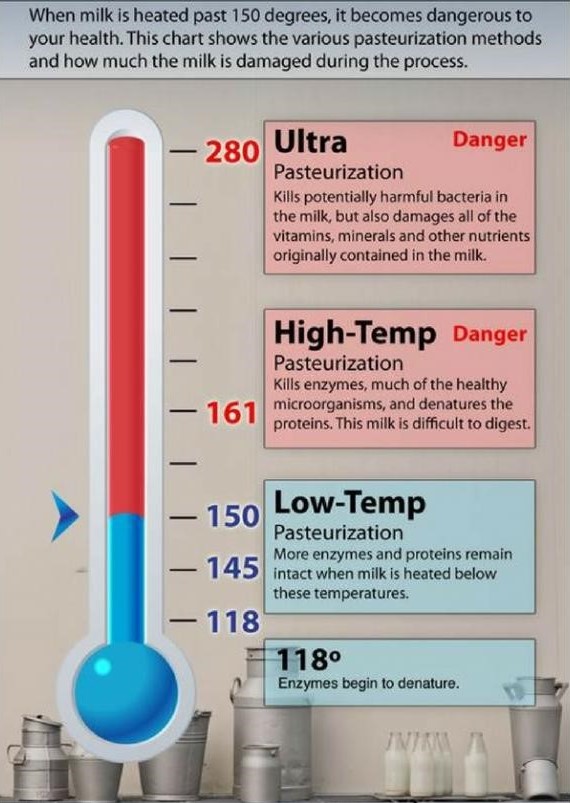
The Purpose of Pasteurization
- To increase milk safety for the consumer by destroying disease causing microorganism (pathogens) that may be present in the Milk. .
- To increase keeping the quality of milk products by destroying spoilage microorganisms and enzymes that contribute to the reduced quality and shelf life of milk.
- Homogenization:- Homogenization is the process of breaking down the fat molecules in milk so that they stay integrated rather than separating as cream. Homogenization is a purely physical process; nothing is added to the milk. At temperature of 60°C, milk is passed under high pressure through small opening of a machine called homogenizer. The main purpose is to subdivide the fat globules in milk and disperse them evenly in the entire mass. Fat has a low density and tends to rise to the surface during heating. Homogenization prevents this by first breaking up the fat into tiny particles and then dispersing them throughout the milk. This adds to the flavour and results in a better body.
Picture view of Homogenization of Milk

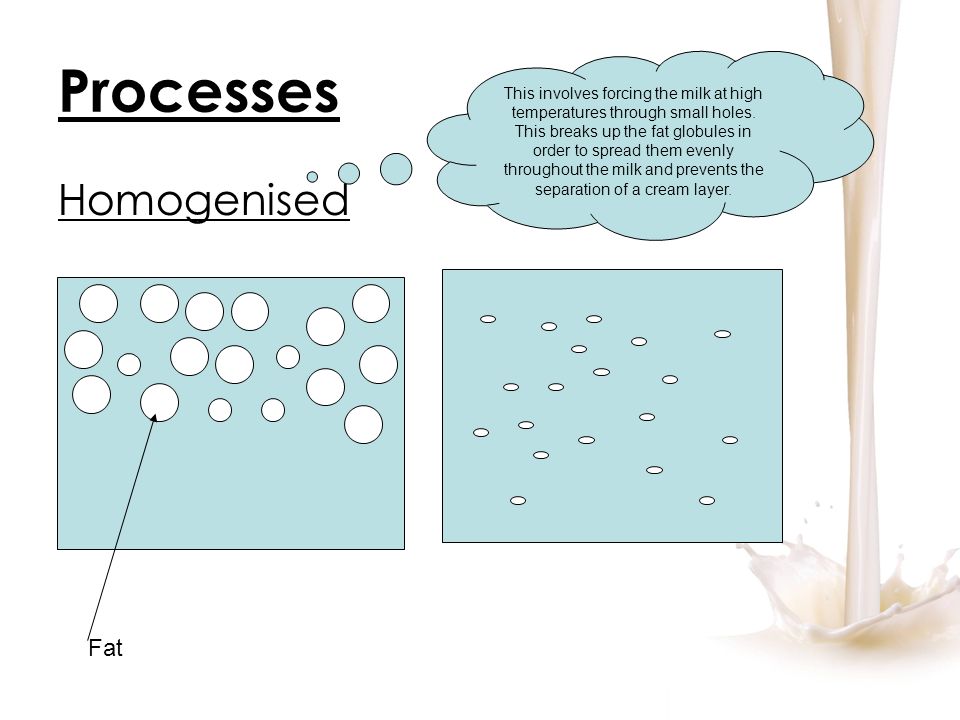
- Bottling or Packaging of Milk:- The bottles of selected and uniform size have to be sterilized by steam and hot water and then they are filled with milk, which are capped automatically. Nowadays milk is filled in plastic pouches and these are more economical, easily transported and save storage space. Plastic pouches are easily disposed and are safe to handle.
Classification of Milk: –
Milk can be classified by many way such as Fat content in Milk, According to processing process such as pasteurized or UHT & According to Non Dairy Milk.
According to Fat Content in Milk:-
The different milks tend to vary according to the way they are produced, and their fat content. The fat content of milk varies depending on the product e.g. whole milk has a fat content of about 4% fat, whole standardised milk, that which is widely available for sale, has a minimum fat content of 3.5% fat, semi skimmed milk contains 1.7% fat, skimmed milk contains about 0.1% fat, and in addition there is 1% fat milk. Dairies in India have to market milk by standardizing, as per the various types of milk prescribed under Food Safety Standard Act, 2006. These type of milk differ in their Milk fat and Milk SNF contents.
| SL.No | Type of Milk | Fat content in Milk ( % Not less than) by weight | SNF (Solid Not Fat) content in Milk ( % Not less than) by weight |
| Cow Milk | 3.5% | 8.5 % | |
| Buffalo Milk | 5 % | 9 % | |
| Standard Milk | 4.5 % | 8.5 % | |
| Full Cream Milk | 6 % | 9 % | |
| Tonned Milk | 3 % | 8.5 % | |
| Double Tonned Milk | 1.5 % | 8.5 % | |
| Skimmed Milk/ No fat milk | Not more than 0.5% | 8.5 % |
Standard Milk:- This is made by combining buffalo milk and skimmed milk. The fat percentage is maintained at 4.5% while the SNF is 8.5%.
Whole Milk:- Whole milk: Natural whole milk is milk with nothing added or removed. Whole milk, also called full cream milk is usually consumed by children, teenagers and body builders. Whole milk is called so because it contains all the milk fat found them. Whole milk is also creamier and full of flavour. Whole milk must contain at least 3.25% milk fat and 8.25% milk solids by weight—
According to Heat treatment/Process of Milk:-
Pasteurized milk: Pasteurisation is the most popular method of heat treatment. It is a relatively mild form of treatment, which kills harmful bacteria without significantly affecting the nutritional value or taste of the milk.
HTST Milk (High temperature short time) Milk– The basic process for whole milk involves heating the milk to a temperature of no less than 71.7ºC for a minimum of 15 seconds (max 25 seconds). This process is known as High Temperature Short Time (HTST).
Higher Heat Shorter time (HHST) Milk:- Milk is heated at 88.3 degree Celcious for at least 1 second and then cooled.
Ultra-Pasteurized Milk- Milk is heated at 137.8 degree Celcious for at least 2 second and then cooled.
Ultra –High temperature Pasteurized Milk:- Milk is heated between 135-150 degree Celcious for at least 4-15 second and then cooled.
Evaporated Milk:- Evaporated milk is a unsweetened condensed milk, usually sold in cans, that is made by removing about 60 percent of the water from ordinary milk. Evaporated milk can be made from whole milk or skim milk. In either case, the milk is homogenized and then the water is removed with gentle heat. The product is sealed in cans which are then heated to kill any bacteria in the milk.

Condensed Milk:- Condensed milk is a sweetened condensed milk, usually sold in cans, that is made by removing about 60 percent of the water from ordinary milk. Condensed milk can be made from whole milk or skim milk.
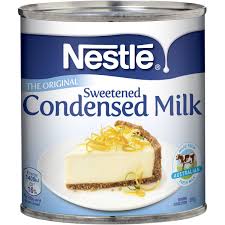
The Difference Between Condensed and Evaporated Milk
Both condensed milk and evaporated milk are forms of concentrated milk in which approximately 60 percent of the water content has been removed. The major difference that sets these two canned milk products apart is sugar content; sweetened condensed milk, as the name implies, is always sweetened, while evaporated milk is unsweetened.
Dry Milk or Milk Power: – Raw milk roughly comprises 87.3 per cent water, 3.9 per cent milk fats and 8.8 per cent non-fat milk solids (protein, milk sugar, minerals, etc.). To obtain milk powder, raw milk is evaporated till it leaves behind milk solids minus the moisture content. In short, milk powder is evaporated milk, which is further condensed and processed. During the evaporation process, milk is also pasteurized under controlled temperatures to ward off any bacterial growth. powdered milk is loaded with nutrients; it is a good source of essential minerals and vitamins such as magnesium, calcium, zinc, potassium as well as vitamins A, D, E and K.

What is Fermented Milk:-
Fermented milk products are created when milk ferments with specific kinds of bacteria called Lactobacilli or Bifidobacteria. Fermentation means the milk is partially digested by the bacteria. This makes the milk product easier to digest, especially for people who have milk allergies or are lactose-intolerant
Example of Fermented Milk:-
Soured milk/Butter Milk:- is produced by the acidification of milk. Acidification, which gives the milk a tart taste, is achieved either through bacterial fermentation or through the addition of an acid, such as lemon juice or vinegar.
most buttermilk comes from an industrial process more similar to yogurt-making than churning butter. Bacteria cultures are added to pasteurized low-fat or skim milk, which is left to ferment for 12 to 14 hours at a low temperature (optimally 69 degrees Fahrenheit). Salt, stabilizers, and sugar may also be added. This type of buttermilk is usually labeled “cultured buttermilk.” Buttermilk can also be enjoyed as a drink, especially to improve gut health and aid in digestion.
About Plant Milk/Vegan Milk
Non dairy Milk or Plant Milk is made from a water-based plant extract for flavouring and aroma. Common plant milks are almond milk, coconut milk, rice milk, and soy milk.
SOYA MILK
Soya milk is arguably the most popular and easiest-to-find non-dairy milk on the market. Made from soya beans, fortified soya milk has just as much protein as cows’ milk and is a great source of calcium and vitamin D. since most soy milk is fortified, is a comparable source of calcium. Vegans should make sure to find a brand that is fortified with Vitamin B12. Soy milk is an excellent dairy substitute for vegan baking or for kids.
Popular Brand of Soya Milk:-SOFIT, SILK, SOYAFRESH, ALPRO & STEATA etc.
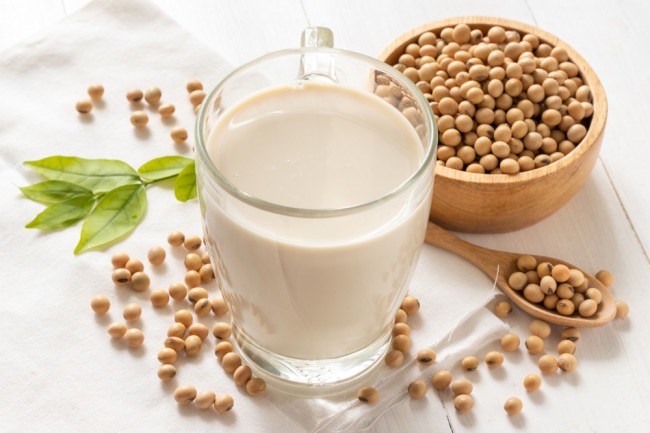 |  |
Use of Soya Milk in Cooking:- Soy milk is good for drinking straight from the glass, poured over cereal or in coffee. The taste is nutty and slightly sweet. When it comes to cooking, soy milk is one of the best milks to choose. It can be used in place of cow’s milk in any recipe. It is stable at high temperatures which makes it a good choice for savory dishes and sauces. In baking, soy milk is also one of the best choices because of its high protein content. soy milk is also the best choice when making vegan buttermilk for Vegan Buttermilk Biscuits or for dredging to make breaded dishes like “Chicken-Fried” Tofu Steaks.
Almond milk is made from almonds & water. This non-dairy milk has a tasty nutty flavour, and also great for vegans who have soya allergies since it’s soya-free. Almonds are a great source of protein, fibre, vitamin E and calcium. It is fortified with calcium & has low calorie & thinner texture.
Popular almond milk brand: Urban Platter, Silk, Raw Pressery, Good Mylk.
 |  |
Use of Almond Milk in Cooking:- Almond milk is slightly sweet, nutty and creamy. It is delicious straight from the glass, in your coffee or poured over cereal. Almond milk can be used in all recipes, sweet and savory, though some might find it a bit sweet for savory dishes and prefer to reserve almond milk for desserts and smoothies.
Coconut Milk:- Coconut milk comes from the white flesh of mature brown coconuts, which are the fruit of the coconut tree. solid coconut flesh is mixed with water to make coconut milk, which is about 50% water. The milk has a thick consistency and a rich, creamy texture. Coconut milk should not be confused with coconut water, which is found naturally in immature green coconuts.
 | 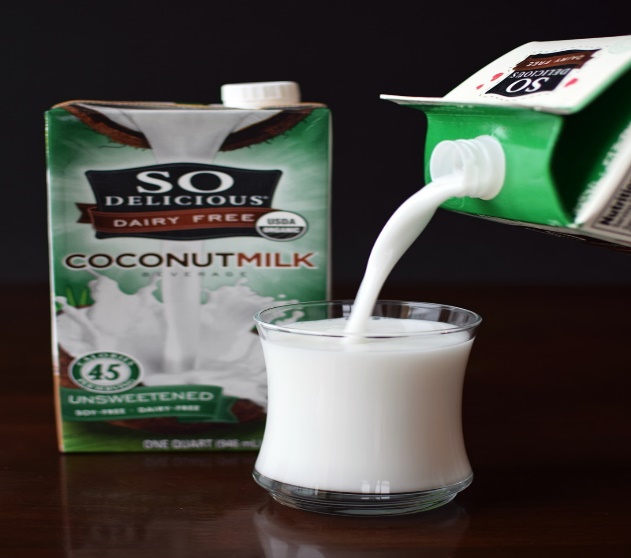 |
Other Non dairy milk are- Rice Milk, cashewnut milk, Hemp milk, oat milk etc.
Use of coconut Milk in Cooking: –
Coconut milk is ideal for drinking straight from the glass, adding to coffee or smoothies or pouring over cereal. It works well in cooking and baking. The coconut flavor is there but when added to recipes, it isn’t too strong to have to avoid it in savory dishes. It is thick enough to whip into whipped cream and to make creamy puddings
Hemp Milk:-
Hemp milk has more protein than other non-dairy milks other than soy milk. One cup has 3 grams of fat, 5 grams of protein and an entire day’s recommended intake of omega-3 fats. Hemp milk is thick and creamy. It has a strong taste that may be better suited to savory dishes though its protein content makes it a good alternative to soy milk for baking
